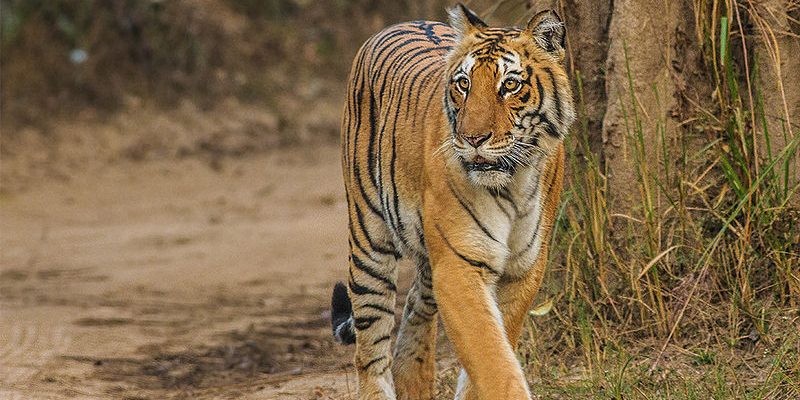Best WildLife National park In India
Ranthambore WildLife National Park
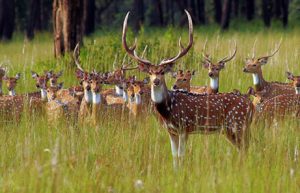
Ranthambhore WildLife National Park (Hindi): रणथंभौर राष्ट्रीय उद्यान) or Ranthambhore is the fortieth largest wildlife national parks in northern India, covering 392 km². Ranthambhore was established as the Sawai Madhopur Game Sanctuary in 1955 by the Government of India and was declared one of the Project Tiger reserves in 1973. Ranthambhore became a wildlife national park in 1980. In 1984, the adjacent forests were declared the Sawai Man Singh Sanctuary and Keladevi Sanctuary, and in 1991 the tiger reserve was enlarged to include the Sawai Man Singh and Keladevi sanctuaries.
Ranthambhore wildlife National Park is known for its Bengal tigers, and is one of the best places in India to see these animals in their natural jungle habitat. Tigers can be easily spotted even in the daytime. The best times for tiger sightings at Ranthambhore National Park are in November and May. The park’s deciduous forests are characteristic examples of the type of jungle found in Central India. Other fauna include the Indian leopard, nilgai, wild boar, sambar, striped hyena, sloth bear, southern plains gray langur, rhesus macaque, mugger crocodile and chital. The sanctuary is home to a wide variety of trees, plants, birds and reptiles, as well as one of the largest banyan trees in India.
It is situated in the Sawai Madhopur district of southeastern Rajasthan, about 110 km northeast of Kota and 140 km southeast of Jaipur, which is also the nearest airport. The nearest town and railway station is at Sawai Madhopur, about 11 km away. The park is also close to the Kota railway station. RIDCOR operates a mega-highway between Kota and Ranthambhore. Ranthambhore National Park lies at the edge of a plateau and is bounded to the north by the Banas River and to the south by the Chambal River. It is named after the historic Ranthambhore fortress, which lies within the park.
Source: Wikipedia Ranthambhore National Park
Sundarbans National Park
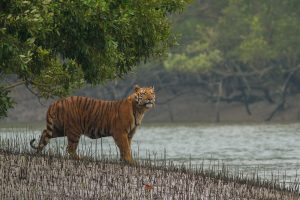
The Sundarbans National Park is a WildLife National Park, Tiger Reserve, and a Biosphere Reserve in West Bengal, India. It is part of the Sundarbans on the Ganges Delta, and adjacent to the Sundarban Reserve Forest in Bangladesh. The delta is densely covered by mangrove forests, and is one of the largest reserves for the Bengal tiger. It is also home to a variety of bird, reptile and invertebrate species, including the salt-water crocodile. The present Sundarban National Park was declared as the core area of Sundarban Tiger Reserve in 1973 and a wildlife sanctuary in 1977. On 4 May 1984 it was declared a National Park. It is a UNESCO world heritage site inscripted in 1987. It is considered as a World Network of Biosphere Reserve (Man and Biosphere Reserve) in 2001.
The first Forest Management Division to have jurisdiction over the Sundarbans was established in 1869. In 1875 a large portion of the mangrove forests was declared as reserved forests under the Forest Act, 1865 (Act VIII of 1865). The remaining portions of the forests were declared a reserve forest the following year and the forest, which was so far administered by the civil administration district, was placed under the control of the Forest Department. A Forest Division, which is the basic forest management and administration unit, was created in 1879 with the headquarters in Khulna, Bangladesh. The first management plan was written for the period 1893–98.
In 1911, it was described as a tract of unexamined waste country and was excluded from the census. It then stretched for about 266 kilometres (165 mi) from the mouth of the Hugli to the mouth of the Meghna river and was bordered inland by the three settled districts of the 24 par par, Khulna and Bakerganj. The total area (including water) was estimated at 16,900 square kilometres (6,526 sq mi). It was a water-logged jungle, in which tigers and other wild beasts abounded. Attempts at reclamation had not been very successful. The Sundarbans was everywhere intersected by river channels and creeks, some of which afforded water communication throughout the Bengal region both for steamers and for native ships.
Source: Wikipedia Sundarbans National Park
Jim Corbett National Park, Uttarakhand
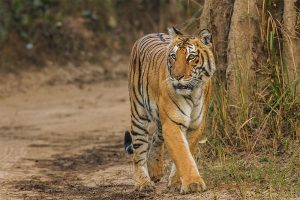
Jim Corbett National Park is the oldest WildLife national park in India and was established in 1936 as Hailey National Park to protect the endangered Bengal tiger. It is located in Nainital district of Uttarakhand and was named after Jim Corbett who played a key role in its establishment. The park was the first to come under the Project Tiger initiative.
The park has sub-Himalayan belt geographical and ecological characteristics. An ecotourism destination, it contains 488 different species of plants and a diverse variety of fauna. The increase in tourist activities, among other problems, continues to present a serious challenge to the park’s ecological balance.
Corbett has been a haunt for tourists and wildlife lovers for a long time. Tourism activity is only allowed in selected areas of Corbett Tiger Reserve so that people get an opportunity to see its splendid landscape and the diverse wildlife. In recent years the number of people coming here has increased dramatically. Presently, every season more than 70,000 visitors come to the park.
Corbett WildLife National Park comprises 520.8 km2 (201.1 sq mi) area of hills, riverine belts, marshy depressions, grasslands and a large lake. The elevation ranges from 1,300 to 4,000 ft (400 to 1,220 m). Winter nights are cold but the days are bright and sunny. It rains from July to September.
Dense moist deciduous forest mainly consists of sal, haldu, peepal, rohini and mango trees. Forest covers almost 73% of the park, 10% of the area consists of grasslands. It houses around 110 tree species, 50 species of mammals, 580 bird species and 25 reptile specie.
Source: Wikipedia Jim Corbett National Park, Uttarakhand
Gir National Park, Gujarat
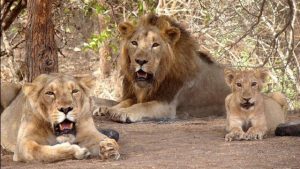
Gir Forest National Park and Wildlife Sanctuary (also known as Sasan-Gir) is a forest and wildlife sanctuary near Talala Gir in Gujarat, India. Established in 1965, with a total area of 1,412 km2 (545 sq mi) (about 258 km2 (100 sq mi) for the fully protected area of the national park and 1,153 km2 (445 sq mi) for the Sanctuary, the park is located 43 km (27 mi) north-east of Somnath, 65 km (40 mi) south-east of Junagadh and 60 km (37 mi) south-west of Amreli.[1] Its ecoregion is that of Kathiawar-Gir dry deciduous forests, which not only includes Kathiawar Peninsula, where the forest is located, but also other places, like Ranthambore National Park in Rajasthan.
Its region is the sole home of the Asiatic lion (Panthera leo persica) in the wilderness, and is considered to be one of the most important protected areas in Asia due to its supported species. The ecosystem of Gir, with its diverse flora and fauna, is protected as a result of the efforts of the government forest department, wildlife activists and NGOs. The forest area of Gir were the hunting grounds of the Nawabs of Junagadh. However, faced with a drastic drop in the lion population in Gir, after British viceroys brought to his attention the plight of the lion in Asia, the sanctuary is the jewel of Gujarat’s ecological resources. His son, Nawab Muhammad Mahabat Khan III later assisted in the conservation of the lions whose population had plummeted to only 20 through slaughter for trophy hunting.
The 14th Asiatic Lion Census 2015 was conducted in May 2015. In 2015, the population has been 523 (27%) up compared to previous census in 2010). The population was 411 in 2010 and 359 in 2005. The population of lions in Junagadh District has been 268, Gir Somnath District has been 44, Amreli District has been 174 (highest increase) and Bhavangar District has been 37. There are 109 males, 201 females and 213 young/cubs.
Source: Wikipedia Gir National Park, Gujarat
Bannerghatta Biological Park, Karnataka

Bannerghatta WildLife National Park, near Bangalore, Karnataka, was founded in 1970 and declared as a national park in 1974. In 2002 a portion of the park, became a biological reserve, the Bannerghatta Biological Park. It is a popular tourist destination with a zoo, a pet corner, an animal rescue centre, a butterflyenclosure, an aquarium, a snake house and a safari park. There are ancient temples in the park for worship and it is a destination for trekking and hiking. The Zoo Authority of Karnataka, the University of Agricultural Sciences, Bangalore, and the Ashoka Trust for Research in Ecology and Environment (ATREE) are collaborating agencies. Within the national park area are six rural villages enclosed within three large enclosures for sheep and cattle farming. This park offers a wide range of diverse wildlife to the exploradoras. Coming from the finest of Bengaluru, Karnataka, this parks offers a guided bus tour all along the 6 km safari roads, which is specially made for safarists and foreign tourist gatherers.
Source: Wikipedia Bannerghatta Biological Park, Karnataka
Kaziranga National Park, Assam
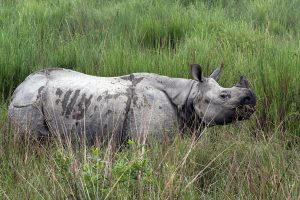
Kaziranga WildLife National Park is a national park in the Golaghat and Nagaon districts of the state of Assam, India. The sanctuary, which hosts two-thirds of the world’s great one-horned rhinoceroses, is a World Heritage Site. According to the census held in March 2015, which was jointly conducted by the Forest Department of the Government of Assam and some recognized wildlife NGOs, the rhino population in Kaziranga National Park is 2,401. It comprises 1,651 adult rhinos (663 male, 802 are females, 186 unsexed); 294 sub-adults (90 males, 114 females, 90 unsexed); 251 juveniles and 205 cubs. Kaziranga is home to the highest density of tigers among protected areas in the world, and was declared a Tiger Reserve in 2006. The park is home to large breeding populations of elephants, wild water buffalo, and swamp deer. Kaziranga is recognized as an Important Bird Area by BirdLife International for conservation of avifaunal species. When compared with other protected areas in India, Kaziranga has achieved notable success in wildlife conservation. Located on the edge of the Eastern Himalaya biodiversity hotspot, the park combines high species diversity and visibility.
Kaziranga is a vast expanse of tall elephant grass, marshland, and dense tropical moist broadleaf forests, criss-crossed by four major rivers, including the Brahmaputra, and the park includes numerous small bodies of water. Kaziranga has been the theme of several books, songs, and documentaries. The park celebrated its centennial in 2005 after its establishment in 1905 as a reserve forest.
Source: Wikipedia Kaziranga National Park, Assam
Periyar National Park, Kerala

Periyar National Park and Wildlife Sanctuary (PNP) is a protected area near Thekkady in the districts of Idukki, Kottayam and Pathanamthitta in Kerala, India. It is notable as an elephant reserve and a tiger reserve. The protected area covers an area of 925 km2 (357 sq mi). 305 km2 (118 sq mi) of the core zone was declared as the Periyar National Park in 1982. The park is a repository of rare, endemic and endangered flora and fauna and forms the major watershed of two important rivers of Kerala, the Periyar and the Pamba.
The park is often called the Periyar Wildlife Sanctuary or Thekkady. It is located high in the Cardamom Hills and Pandalam Hills of the south Western Ghats along the border with Tamil Nadu. It is 4 km (2.5 mi) from Kumily, approximately 100 km (62 mi) east of Kottayam, 110 km (68 mi) west of Madurai and 120 km (75 mi) southeast of Kochi.
Source: Wikipedia Periyar National Park, Kerala
Bandhavgarh National Park, Madhya Pradesh

Bandhavgarh WildLife National Park (Devanagari: बांधवगढ राष्ट्रीय उद्यान) is one of the popular national parks in India located in the Umaria district of Madhya Pradesh. Bandhavgarh was declared a national park in 1968, with an area of 105 km2. The buffer is spread over the forest divisions of Umaria and Katni and totals 820 km2. The park derives its name from the most prominent hillock of the area, which was said to be given by Hindu Lord Rama to his brother Lakshmana to keep a watch on Lanka (Ceylon). Hence the name Bandhavgarh (Sanskrit: Brother’s Fort).
This park has a large biodiversity. The density of the tiger population at Bandhavgarh is one of the highest known in India. The park has a large breeding population of leopards, and various species of deer. Maharaja Martand Singh of Rewa captured the first white tiger in this region in 1951. This white tiger, Mohan, is now stuffed and on display in the palace of the Maharajas of Rewa. Historically villagers and their cattle have been a threat to the tiger. Rising mining activities around the park are putting the tigers at risk.
Source: Wikipedia Bandhavgarh National Park, Madhya Pradesh
Hemis National Park, Jammu Kashmir

Hemis WildLife National Park (or Hemis High Altitude National Park) is a high altitude national park in the eastern Ladakh region of the state of Jammu and Kashmir in India. World famous for being the best place to see the snow leopard in the wild, it is believed to have the highest density of snow leopards of any protected area in the world.[1] It is the only national park in India north of the Himalayas, the largest notified protected area in India (and thus the largest national park of India), and is the second largest contiguous protected area after the Nanda Devi Biosphere Reserve and surrounding protected areas. The park is home to a number of species of endangered mammals including the snow leopard. Hemis National Park is India’s only protected area inside the Palearctic ecozone, outside the Changthang Wildlife Sanctuary northeast of Hemis, and the proposed Tso Lhamo Cold Desert Conservation Area in North Sikkim.
The park is bounded on the north by the banks of the Indus River, and includes the catchments of Markha, Sumdah and Rumbak, and parts of the Zanskar Range.
Source: Wikipedia Hemis National Park, Jammu Kashmir
The Great Himalayan National Park, Himachal Pradesh
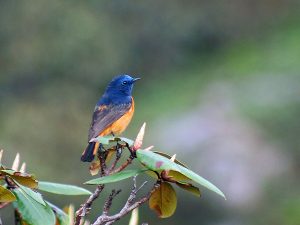
The Great Himalayan WildLife National Park (GHNP), is one of India’s national parks, is located in Kullu region in the state of Himachal Pradesh. The park was established in 1984 and is spread over an area of 1,171 km2 at an altitude of between 1500 and 6000 m. The Great Himalayan National Park is a habitat to numerous flora and more than 375 fauna species, including approximately 31 mammals, 181 birds, 3 reptiles, 9 amphibians, 11 annelids, 17 mollusks and 127 insects. They are protected under the strict guidelines of the Wildlife Protection Act of 1972; hence any sort of hunting is not permitted.
In June 2014, the Great Himalayan National Park was added to the UNESCO list of World Heritage Sites. The Unesco World Heritage Site Committee granted the status to the park under the criteria of “outstanding significance for biodiversity conservation”.
Source: Wikipedia The Great Himalayan National Park, Himachal Pradesh
